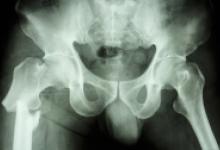Axial Disease in Psoriatic Arthritis Save

Inflammatory involvement of the axial skeleton and sacroiliac joints occurs, on average, in 40-50% of patients with psoriatic arthritis (PsA).
When present, axial involvement is a “biomarker” of more severe PsA disease: more severe peripheral joint disease, enthesitis, skin disease, pain, impaired function and quality of life, and work productivity1. Thus, it is important to recognize and include in a comprehensive PsA treatment approach. Axial PsA (axPsA) frequency ranges from 5-25% when evaluated early in the course of PsA and in up to 75% when evaluated later in the course of the disease2,3. Thus, unlike axial spondyloarthritis (axSpA), which more often begins in a patient’s 20s or 30s, when axPsA appears later in a patient’s life, it is harder to distinguish from symptoms and signs of degenerative arthritis of the spine.
Other important clinical differences from axSpA include the fact that some axPsA patients may not be symptomatic even when there is clear evidence of axial inflammation, not all patients with axPsA will endorse classic inflammatory back pain (IBP) features such as improvement with activity, worsening with rest, and being awoken by pain, symptoms and signs may present in the spine and not in the sacroiliac joints, active peripheral arthritis and enthesitis will more likely be present, and occurs more equally between sexes. Additional differences between axPsA and axSpA occur in imaging findings. For example, evidence of sacroiliitis on x-ray or MRI may be absent in axPsA or present asymmetrically with unilateral sacroiliitis. Syndesmophytes, intervertebral calcific bridges, appear chunky, may be unilateral, and may skip vertebral segments, i.e. appearing dissimilar to syndesmophytes of axSpA which are slim, symmetric and marginal. From a genetic perspective, although HLA-B27 may be present in both axSpA and axPsA, it is observed in up to 90% of patients with axSpA but only 25-30% of those with axPsA. In PsA, HLA-B08 and HLA-B38 are associated with axial disease whereas these are not implicated in axPsA. HLA-B08 has been associated with asymmetric sacroiliitis. A deficit in our understanding of the pathophysiology of axPsA and axSpA, i.e. how similar or dissimilar the immunophenotypes are, is the paucity of studies of bone, joint, and enthesial tissue samples to characterize cellular and cytokine pathology. This has to do with the reluctance of patients to undergo biopsy of the spine or sacroiliac joints. Further, surrogate data from animal models is sparse and potentially misleading.
Given the differences that we see between axPsA and axSpA, we must ask – should we automatically accept the results of treatment trials in radiographic axSpA, i.e. ankylosing spondylitis (AS), or non-radiographic axSpA (nr-axSpA) as the correct basis for our assumptions of treatment effects in axPsA? Will drugs that appear to be effective in axSpA always work in axPsA, or vice versa, will drugs that do not appear to be effective in axSpA also not perform adequately in axPsA?
Historically, treatment recommendations from organizations such as EULAR, GRAPPA and ACR-NPF do accept the results of axSpA clinical trials as proof of effectiveness of a drug in the axial component of PsA and in clinical practice, in general, this assumption appears to be appropriate. Thus, for example, the GRAPPA treatment recommendations recommend the use of TNF, IL-17, and JAK inhibitors in axPsA based on good quality data from ankylosing spondylitis trials. The only effort to further corroborate this in axPsA was a trial with secukinumab. In the MAXIMISE trial, 498 patients considered by their physicians to have axPsA and elevated BASDAI and spine pain scores were randomized to receive secukinumab 300 mg or 150 mg per month vs. placebo. Baseline imaging, including pelvis and spine MRI was performed, but having imaging consistent with inflammatory spondylitis was not part of the inclusion criteria. Approximately 30% of the population was HLA-B27 positive, which fits with what we expect for an axPsA cohort. At 12 weeks, both secukinumab dose arms achieved > 60% ASAS20 response vs. 31% in the placebo group, again, a result we would anticipate with an effective treatment for axPsA based on results observed in axSpA trials. These results reassure us that IL-17 inhibition works as well in axPsA as axSpA. Interestingly, analysis of baseline MRI results revealed that 40% of the patients did not demonstrate inflammatory activity in pelvis or spine. Yet whether the patients were MRI+ or not, similar results were shown with treatment as for the overall group. This raises an important question – in the to-be-developed axPsA classification criteria that is the objective of the AXIS study now being pursued collaboratively by ASAS and GRAPPA, how will we account for and include those patients who are MRI negative for inflammation but may still have axPsA?
Meanwhile, a more controversial picture has emerged about IL-23 inhibition in the treatment of axial inflammation. In immunologic pathways, IL-23 is “upstream” from IL-17 production by TH17 cells when stimulated by IL-23. Based on this knowledge plus the apparently favorable results (ASAS responses and MRI changes) of an open label study of 20 German ankylosing spondylitis patients treated with ustekinumab, an IL-12/23 inhibitor, several placebo-controlled studies were conducted with drugs inhibiting IL-23 in ankylosing spondylitis. A phase 2 trial of risankizumab, a p19-IL-23 inhibitor, and a large phase 3 trial of ustekinumab in AS both showed no benefit of treatment vs. placebo. These results were surprising and have led to conjectures about potential immunophenotypic differences of spinal tissues (bone, entheses, and joints) such that IL-23 may not be as important a pro-inflammatory cytokine in the pathogenesis of spine disease4, 5. For example, if the spinal disease is driven more by resident immune cells which produce IL-17 independent of IL-23 stimulation. Nonetheless, the question remains, might IL-23 inhibition be more successful in axPsA if there is enough immunophenotypic difference from axSpA such that a substantial subset of those with PsA axial involvement could respond? Fledgling evidence for this has been demonstrated in a subset of patients studied in the phase 3 DISCOVER 1 and 2 trials of guselkumab, a p19-IL-23 inhibitor, in PsA6. To derive this subset, investigators identified patients they thought had axPsA, had elevated spine pain and BASDAI scores, and who had either xray or MRI changes of the sacroiliac joints (local radiologist interpretation verified by the rheumatologist) considered to be consistent with sacroiliitis. There were 312 patients who fulfilled these criteria, 28% of the total population in the combined trials. HLA-B27 positivity was noted in approximately 30%. At the primary endpoint of the study, 24 weeks, statistically more patients in the two guselkumab treatment arms responded as measured by such measures as BASDAI, spinal pain, ASDAS Major Improvement and Inactive Disease. These responses were maintained at 52 weeks. Although this substudy cannot be considered definitive proof of benefit, due to features such as local read of baseline images and absence of serial axial MRI scans to complement the clinical measures, nonetheless it raises the possibility that a treatment that does not appear to benefit axSpA may benefit axPsA. Based on these results, a large placebo-controlled trial of guselkumab dedicated to patients with axPsA with MRI-verified axial inflammation is now underway, to provide more definitive evidence for benefit, or not, of an IL-23 inhibitor in axPsA.
In conclusion, axPsA, present in approximately 40% of patients with PsA, has unique clinical and imaging features, genetic profile, and possibly immunophenotype which distinguish it from axSpA. Although in general it appears that conclusion about treatment effectiveness will cross over between these two conditions, it appears that some treatments may need to be tested specifically in axPsA cohorts to best ascertain effectiveness. A collaborative project between ASAS and GRAPPA to develop classification criteria for axPsA will greatly aid conduct of studies in appropriately defined populations.
1. Mease PJ, Palmer JB, Liu M, et al. Influence of Axial Involvement on Clinical Characteristics of Psoriatic Arthritis: Analysis from the Corrona Psoriatic Arthritis/Spondyloarthritis Registry. J Rheumatol. 2018;45(10):1389-96.
2. Feld J, Ye JY, Chandran V, et al. Is axial psoriatic arthritis distinct from ankylosing spondylitis with and without concomitant psoriasis? Rheumatology (Oxford). 2020;59(6):1340-6.
3. Feld J, Chandran V, Haroon N, et al. Axial disease in psoriatic arthritis and ankylosing spondylitis: a critical comparison. Nature reviews Rheumatology. 2018;14(6):363-71.
4. Siebert S, McGucken A, McInnes IB. The IL-23/IL-17A axis in spondyloarthritis: therapeutics informing pathogenesis? Curr Opin Rheumatol. 2020;32(4):349-56.
5. Mease P. Ustekinumab Fails to Show Efficacy in a Phase III Axial Spondyloarthritis Program: The Importance of Negative Results. Arthritis Rheum. 2019;71(2):179-81.
6. Mease P, Helliwell P, Gladman D, et al. Efficacy of guselkumab on axial involvement in patients with active psoriatic arthritis and sacroiliitis: a post-hoc analysis of the phase 3 DISCOVER-1 and DISCOVER-2 studies. The Lancet Rheumatology. 2021;3(10):e715-23.







If you are a health practitioner, you may Login/Register to comment.
Due to the nature of these comment forums, only health practitioners are allowed to comment at this time.